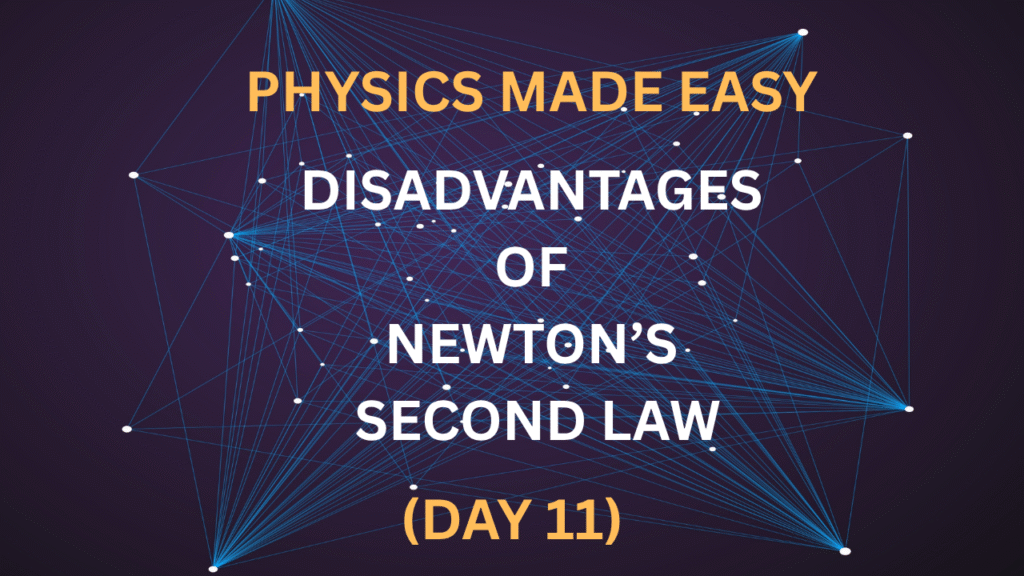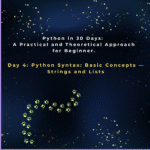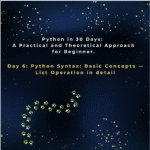Introduction
Welcome to Day 5! Yesterday, you learned all about strings. Today, we will explore another fundamental data structure in Python: Python lists. A list is an incredibly versatile and powerful tool that allows you to store a collection of items in a single variable. While strings are also sequences of characters, Python lists are far more flexible because they are mutable, meaning they can be changed after they are created.
You can follow along by running each code snippet in an online editor.
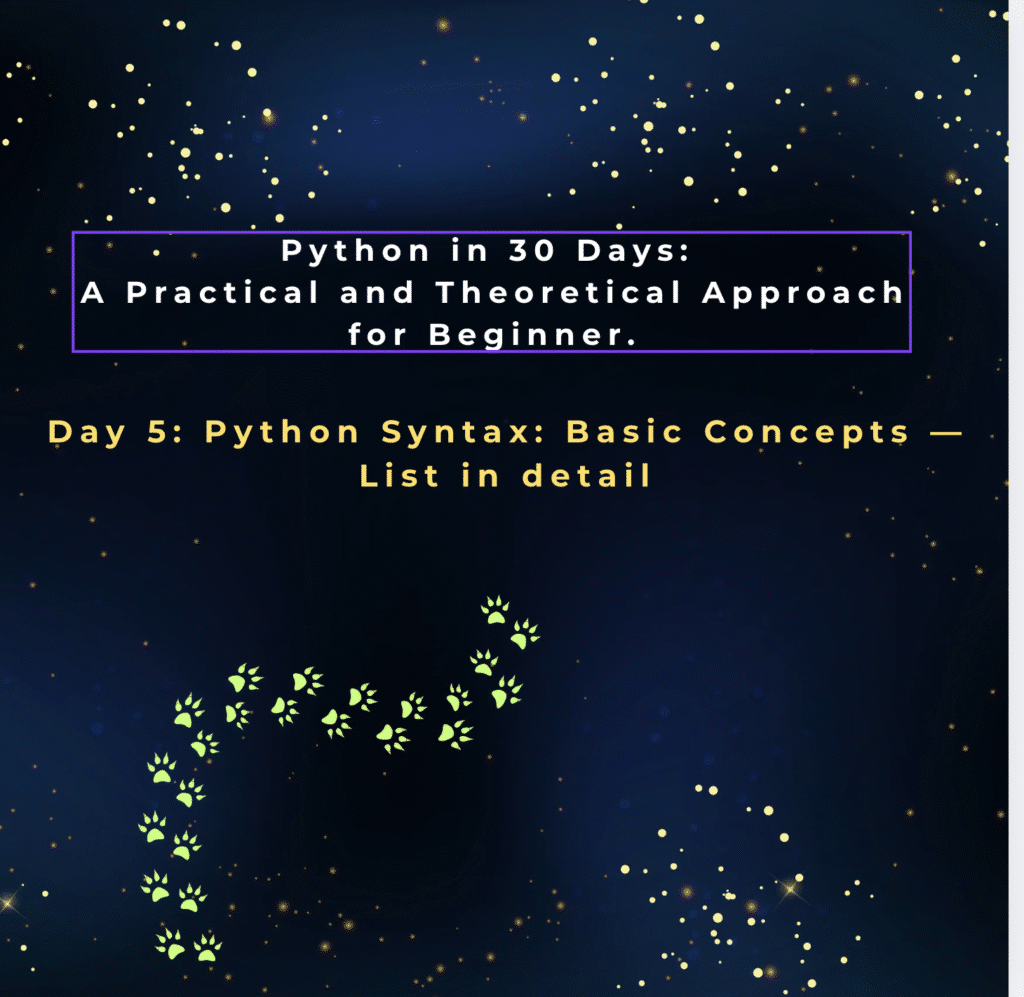
What are Python Lists?
A list in Python is a collection of items that has three key characteristics, which make it a go-to data structure for many programming tasks.
- Ordered: The items in a list have a specific, defined order, and this order will not change unless you modify the list. This means you can always rely on an item being at the same position (index) as long as you don’t re-sort or reorder the list.
- Mutable: Lists are “changeable.” This is their key difference from strings. You can add, remove, or modify items after a list has been created, which is an invaluable feature for dynamic programs.
- Heterogeneous: A list can store elements of different data types at the same time, such as integers, strings, floats, and even other lists. This flexibility allows you to store complex data in a single list variable.
SYNTAX: Python lists are defined by placing comma-separated items inside square brackets [].
Pythonlist_name = [element1, element2, element3, ...]
# Example of a Heterogeneous List
mixed_list = ["apple", 3, 5.9, True, ["another", "list"]]
print(mixed_list) # Output: ['apple', 3, 5.9, True, ['another', 'list']]
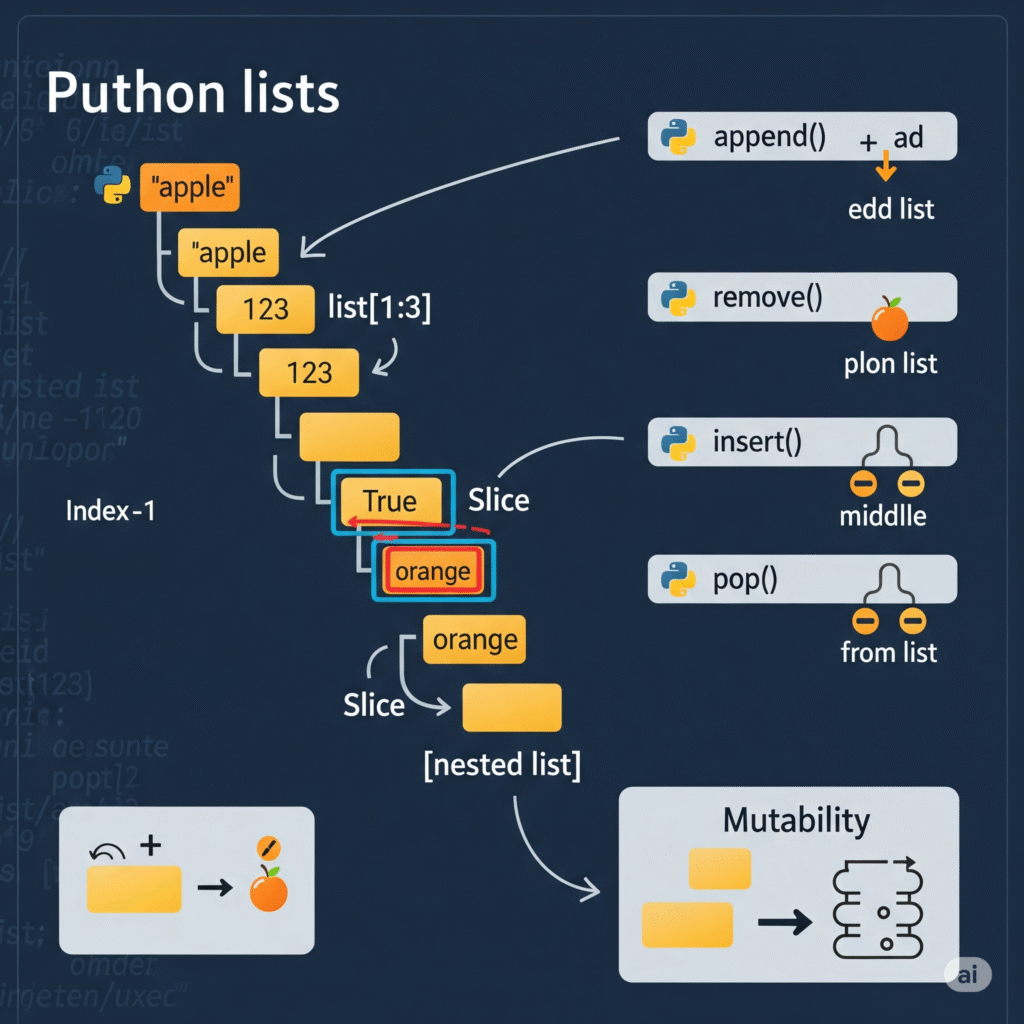
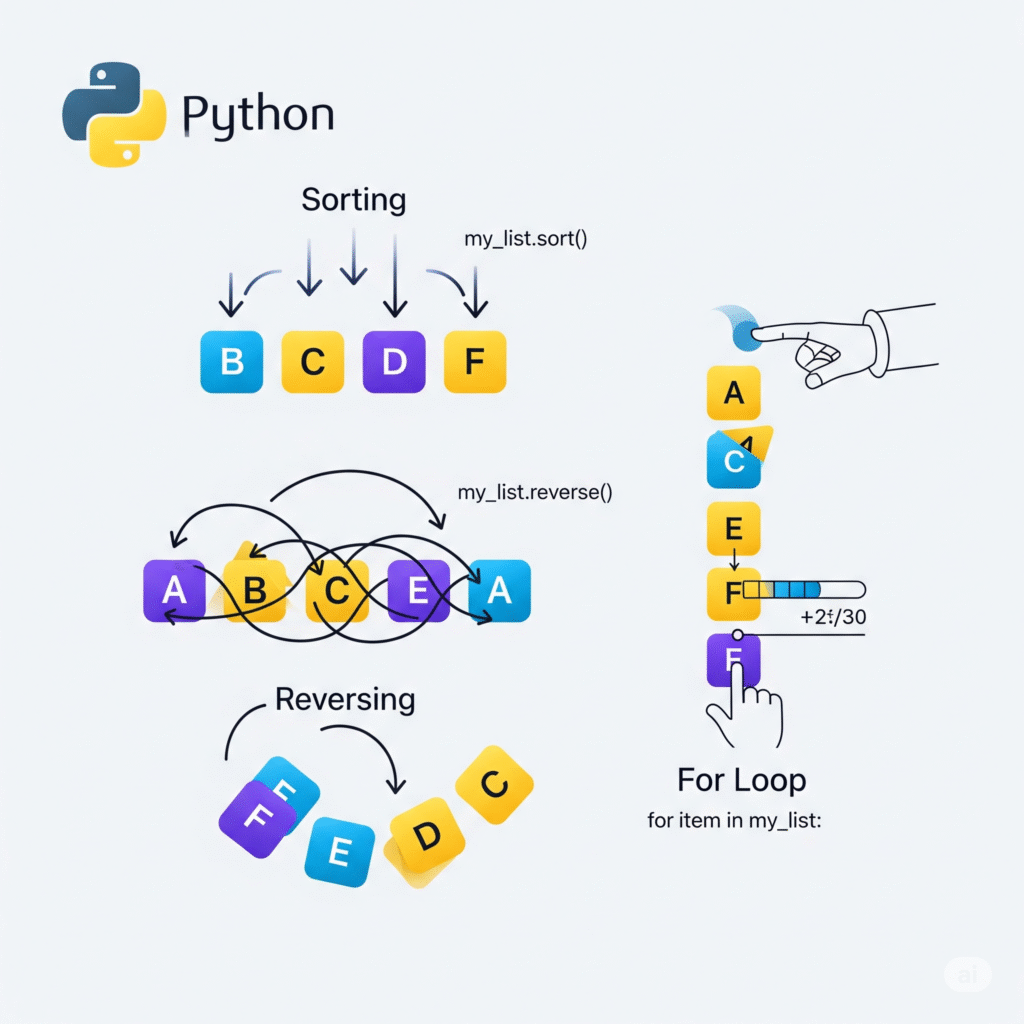
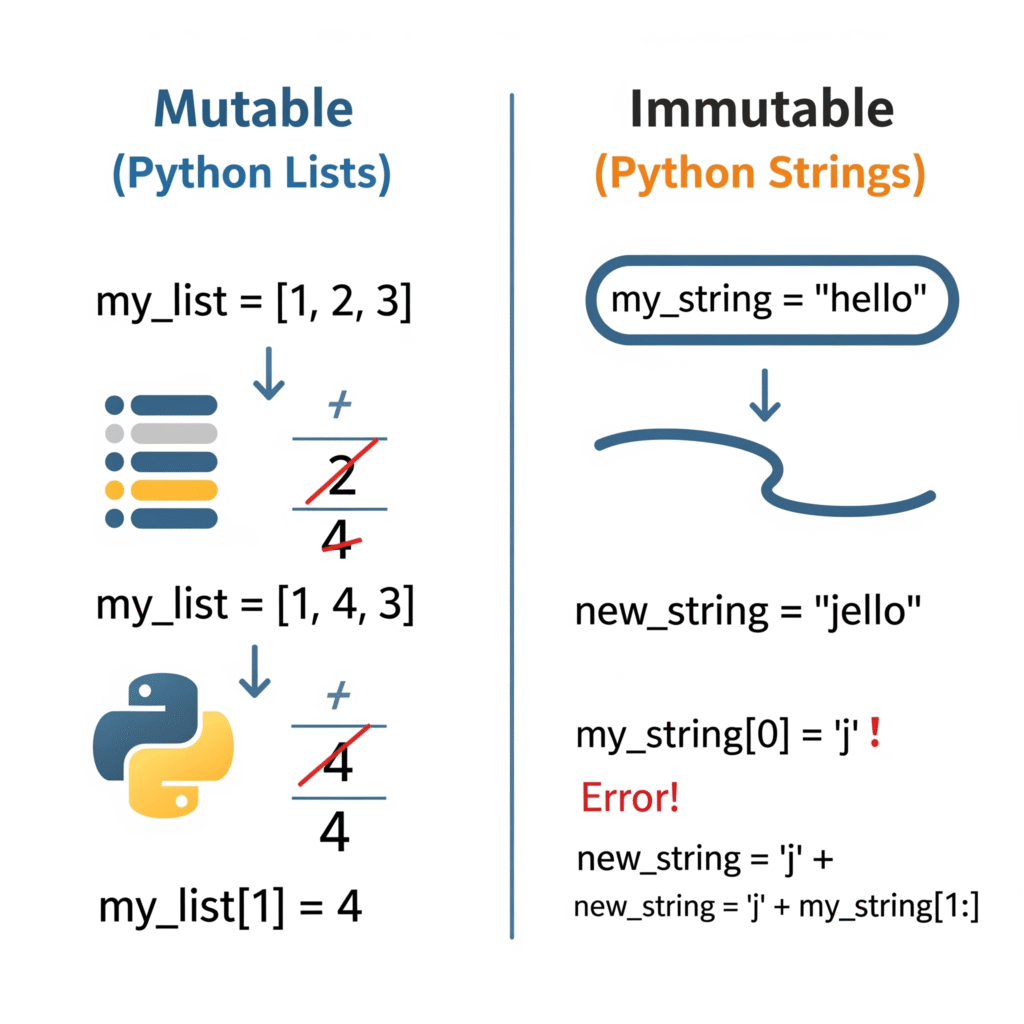
Accessing and Modifying Python Lists
Just like with strings, the items in a list are indexed starting from 0. You can access individual items, or even a range of items, using these indices.
1. Creating and Accessing Elements
Let’s start with a simple list of fruits:
Python# Creating a List
fruits = ["apple", "banana", "cherry", "orange"]
# Accessing elements by positive index (starting from 0)
print(fruits[0]) # Output: apple
print(fruits[2]) # Output: cherry
2. Negative Indexing
You can also use negative indices to access items from the end of the list. The last item is at index -1, the second to last is at index -2, and so on.
Python# Negative indexing
print(fruits[-1]) # Output: orange
print(fruits[-2]) # Output: cherry
3. Slicing a List
Slicing a list works just like slicing a string. You can extract a portion of the list using the syntax [start:end]. Remember, the item at the end index is not included.
Python# Slicing a list
print(fruits[1:3]) # Output: ['banana', 'cherry']
4. Modifying an Element
Because Python lists are mutable, you can easily change the value of an item at a specific index.
Python# Modifying an element
fruits[1] = "blueberry"
print(fruits) # Output: ['apple', 'blueberry', 'cherry', 'orange']
5. Iterating Through a List
A common task with Python lists is iterating through their items. A for loop is the most common way to do this.
Python# Iterating through a list
for fruit in fruits:
print(fruit)
Essential Python List Methods
Python provides several built-in methods to easily manipulate lists. These are vital for any task involving Python lists. You can find a complete list of these methods in the official Python documentation.
1. Adding Elements
append(): Adds an item to the very end of the list. This is the most common way to grow a list.insert(): Adds an item at a specific, chosen position. It takes two arguments: the index and the item to add.
Pythonfruits.append("grape")
print(fruits) # Output: ['apple', 'blueberry', 'cherry', 'orange', 'grape']
fruits.insert(2, "kiwi")
print(fruits) # Output: ['apple', 'blueberry', 'kiwi', 'cherry', 'orange', 'grape']
2. Removing Elements
remove(): Removes the first item from the list that has the specified value. It’s useful when you know the item you want to remove but not its index.pop(): Removes an item at a specified index. If no index is given, it removes and returns the last item. This is particularly useful when you need to use the item you’re removing.
Pythonfruits.remove("cherry")
print(fruits) # Output: ['apple', 'blueberry', 'kiwi', 'orange', 'grape']
popped_item = fruits.pop(1)
print(popped_item) # Output: blueberry
print(fruits) # Output: ['apple', 'kiwi', 'orange', 'grape']
3. Other Useful List Operations
len(): Returns the number of items in the list.in: Checks if a specific item exists in the list and returnsTrueorFalse.sort(): Sorts the items in the list in ascending order.reverse(): Reverses the order of the items in the list.
Python# Length of the list
print(len(fruits)) # Output: 4
# Check if an item exists
print("kiwi" in fruits) # Output: True
print("mango" in fruits) # Output: False
# Sorting and reversing
numbers = [3, 1, 4, 1, 5, 9]
numbers.sort()
print(numbers) # Output: [1, 1, 3, 4, 5, 9]
numbers.reverse()
print(numbers) # Output: [9, 5, 4, 3, 1, 1]
Summary
Python lists are a go-to data structure for storing and manipulating collections of data. You’ve learned how to:
- Create a list and understand its key characteristics (ordered, mutable, and heterogeneous).
- Access and slice items using positive and negative indices.
- Modify the list by changing elements or using powerful methods like
append(),insert(),remove(), andpop(). - Iterate through a list using a
forloop, a fundamental skill for processing data.
Mastering Python lists is crucial for building functional and dynamic programs.
The journey of learning what Python is is an exciting one, and this “30 Days of Python” series is designed to be your roadmap. Happy coding!
Physics Made Easy: Disadvantages of Newton’s Second Law (Day 11)
Are There…
Physics Made Easy: Advantages of Newton’s Second Law (Day 10)
Why is…
Physics Made Easy: How Force, Mass, and Acceleration Work Together (Day 9)
The Core…
Physics Made Easy: Newton’s Second Law – Deriving the Formula (Day 8)
What Does…
Physics Made Easy: Real-Life Examples of Newton’s Second Law (Day 7)
Quick Recap…
Physics Made Easy: Newton’s Second Law (Day 6)
Introduction Newton’s…

